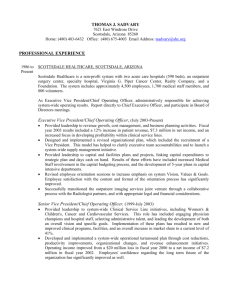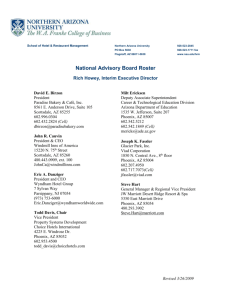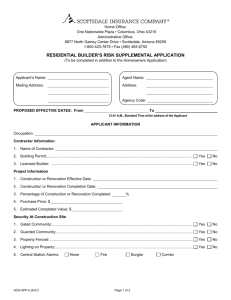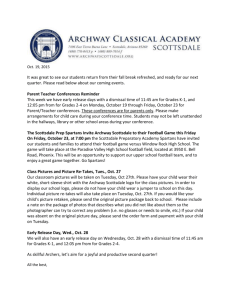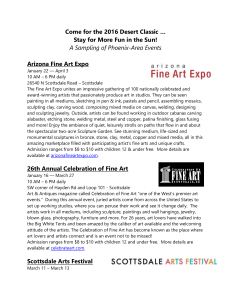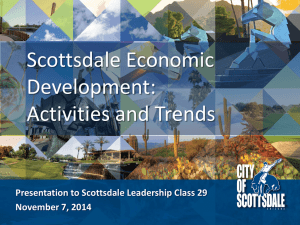Guide - Conference Management Services, Inc.
advertisement
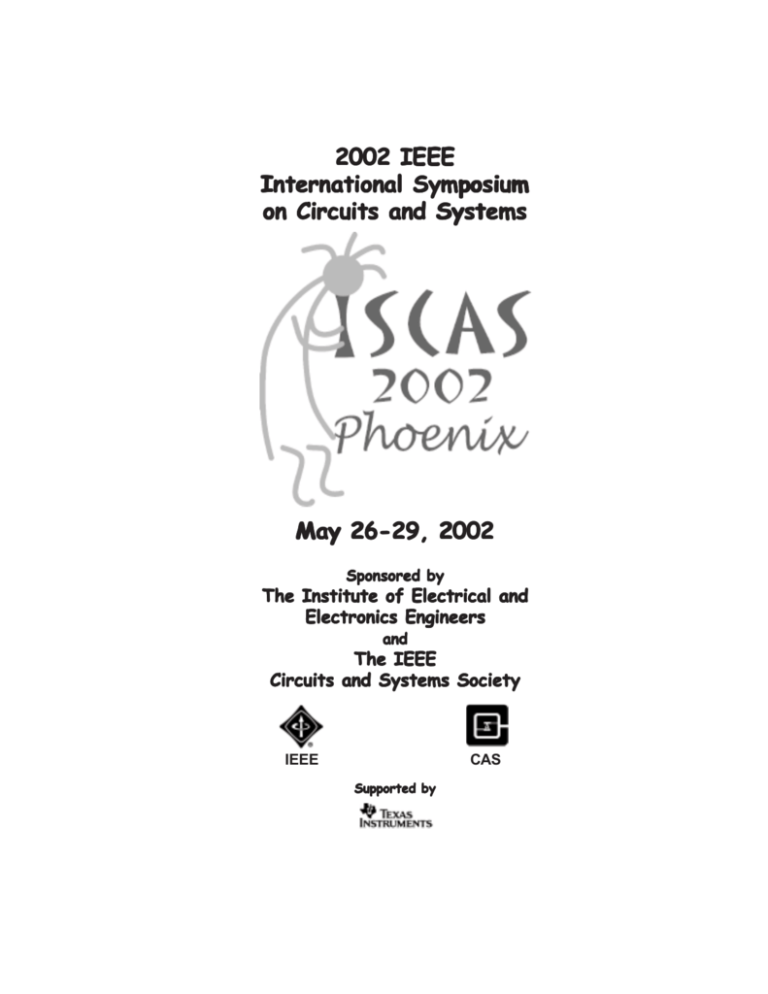
2002 IEEE International Symposium on Circuits and Systems May 26-29, 2002 Sponsored by The Institute of Electrical and Electronics Engineers and The IEEE Circuits and Systems Society IEEE CAS Supported by 1 SCHEDULE AT A GLANCE 2 TABLE OF CONTENTS SCHEDULE AT A GLANCE ............................................. 2 MESSAGE FROM THE CO-GENERAL CHAIRS .......... 4 MESSAGE FROM THE TECHNICAL PROGRAM CHAIR ........................................................................ 5 MESSAGE FROM THE GOVERNOR OF ARIZONA .... 6 MESSAGE FROM THE MAYOR OF SCOTTSDALE .... 7 ORGANIZING COMMITTEE .......................................... 8 TECHNICAL PROGRAM COMMITTEE ...................... 10 USEFUL CONTACTS ..................................................... 11 AIR TRAVEL TO PHOENIX .......................................... 11 AIRPORT-TO-HOTEL TRANSPORTATION ................. 12 LOCAL TRANSPORTATION ......................................... 12 DRIVING DIRECTIONS ................................................ 13 CLIMATE AND CONFERENCE DRESS ....................... 14 VISAS AND ENTRY INTO THE U.S.A. ........................ 14 GUEST SERVICES .......................................................... 15 CONFERENCE SOCIAL EVENTS ................................ 16 INFORMATION FOR SPOUSES .................................... 16 LOCAL RESTAURANTS ................................................ 17 RESTAURANT MAP ...................................................... 19 TUTORIALS .................................................................... 20 KEYNOTE SESSION ...................................................... 24 SPECIAL SESSIONS ....................................................... 25 TECHNICAL PROGRAM ........................................ 26-253 AUTHOR INDEX ................................................... 254-294 PHOTO CREDITS ......................................................... 295 3 Welcome to ISCAS 2002! MESSAGE FROM THE CO-GENERAL CHAIRS It is our great pleasure to welcome all of you to our beloved ISCAS - the International Symposium on Circuits and Systems! We are especially honored to host the first ISCAS to be held in the United States in the new millennium. ISCAS 2002, sponsored by the Institute of Electrical and Electronic Engineers and the IEEE Circuits and Systems Society, is being held at the fabulous Fairmont Scottsdale Princess Resort in Metropolitan Phoenix, Arizona. The conference steering committee has assembled outstanding educational, technical and social programs. In keeping with the tradition of ISCAS, special sessions in emerging and “hot” areas, and lecture and poster sessions that comprise nearly 1100 carefully selected papers, promise spirited engagement, constant excitement, and perhaps a healthy bit of controversy, in an astonishingly beautiful setting. In addition to the wonderful technical program, ISCAS 2002 offers much more! We have prepared exciting social and tourist programs to enable you to enjoy both the atmosphere of ISCAS and the natural beauty of Arizona. The welcome reception, awards ceremony, banquet and closing reception are all designed to expose you to the unique ambience of the desert Southwest. You may also wish to visit some of the many natural wonders and historical sites of Arizona including the Grand Canyon, Sedona, and Wupatki. The Phoenix-Scottsdale area, with its myriad galleries, boutiques, fashion shops, fine restaurants, and architectural wonders will provide you with unlimited opportunities to relax and enjoy your stay in Arizona. Throughout your visit, we promise to showcase the unique hospitality of the desert Southwest. Sethuraman (Panch) Dave Allstot Panchanathan Co-General Chairs, ISCAS 2002 4 A Message from the Technical Program Chair MESSAGE FROM THE TECHNICAL PROGRAM CHAIR The International Symposium on Circuits and Systems is one of the foremost international conferences on the advancement of circuits and systems and their application. ISCAS 2002 will begin with tutorials on Sunday. The program starts on Monday with three keynote sessions, the first of which is entitled “Wireline Broadband Communications,” by Dick Hester of Texas Instruments. Next, Fred Shlapak of Motorola’s Semiconductor Products Sector will present “Challenges for the Future Generations of Systems on Silicon.” The last keynote talk will be “Life-on-a-Chip,” by Deirdre R. Meldrum of the University of Washington. Following the keynote sessions, the regular Technical Program will open. This will consist of 15 parallel sessions divided into four events each day. Every event shall last 1.5 hours and will be composed of 5 orally presented papers and a simultaneous poster session. In addition, 18 special sessions will be conducted in related topics throughout the technical program. The conference will conclude on Wednesday with an evening Closing Reception. On behalf of the Technical Program Committee, I would like to thank you for your participation and cordially welcome you to ISCAS 2002 in Scottsdale, Arizona. Sayfe Kiaei Technical Program Chair, ISCAS 2002 5 A Message from Jane Dee Hull, Governor of Arizona MESSAGE FROM THE GOVERNOR OF ARIZONA Greetings! As Governor of the State of Arizona, I would like to extend a warm welcome to the attendees of the 2002 IEEE International Symposium on Circuits and Systems. Arizona is a state known for its rich heritage and beautiful landscape. Our state’s pride and joy, the Grand Canyon, has been visited by millions of people from every corner of the globe. Arizona has an extremely diverse cultural history that adds to our unique southwestern lifestyle. Arizona’s economy is booming. The formation of several professional sports teams, the abundance of special events hosted by our great State, the plethora of both large and small businesses, and, of course, the beautiful weather, make Arizona an ideal place to host your event. I hope that each of you will take the opportunity after your gathering, to enjoy Arizona’s warm hospitality and unique culture and discover that Arizona is a special place to visit. Sincerely, Jane Dee Hull Governor of Arizona 6 A Message from Mary Manross, Mayor of Scottsdale MESSAGE FROM THE MAYOR OF SCOTTSDALE Welcome to Scottsdale! On behalf of the Scottsdale City Council, the Scottsdale Convention & Visitors Bureau, and the entire community of Scottsdale, I am proud to welcome the 2002 IEEE International Symposium on Circuits and Systems to our city. Scottsdale is where the old west meets the new west, where Native American, Spanish and Western influences abound in a vibrant, contemporary city awash in sunshine. Industry in Scottsdale includes technology, business services and tourism. This relaxed yet elegant city offers premier resorts, excellent golf, world-class shopping and exciting signature events. I invite you to take the time to see Scottsdale Mall, the Civic Center and Old Town Scottsdale where you may visit our fine shops, art galleries, and some of Scottsdale’s finest restaurants. We wish you a very productive and enjoyable meeting. We look forward to your return to Scottsdale in the near future and wish you continued success. Sincerely, Mary Manross Mayor of Scottsdale 7 ORGANIZING COMMITTEE General Co-Chairs Sethuraman (Panch) Panchanathan Arizona State University David J. Allstot University of Washington Technical Program Chair Sayfe Kiaei Arizona State University Technical Program Vice Chairs International Liaison for Asia and Pacific Uday Desai Indian Institute of Technology International Liaison for North America Wasfy B. Mikhael University of Central Florida Vice Chair Jo Dale Carothers University of Arizona Finance Chair James Stansberry Sony Corporation Plenary Sessions Chair John Choma University of Southern California Tutorials Chair Chaitali Chakrabarti Arizona State University Exhibits Chair Charles (Chuck) Higgins University of Arizona Special Sessions Co-Chairs Bertan Bakkaloglu Texas Instruments, Inc. Magdy A. Bayoumi University of Louisiana Electronics and Media Chair K. Selçuk Candan Arizona State University 8 Publications Chair W. Timothy Holman Vanderbilt University Publicity Chair Ramalingam Sridhar State University of New York at Buffalo Local Publicity Rao Thallam Salt River Project Social Events and Tours Chair Jeffrey J. Rodriguez University of Arizona ISCAS Steering Committee Chair Geert De Veirman Agere Systems IEEE CAS Society Liaison David Skellern Macquarie University IEEE CAS Society Administrator Barbara Wehner International Coordinators Regional Vice-Presidents of IEEE CAS Society USA and Canada (Regions 1-7) Wasfy B. Mikhael University of Central Florida Europe, Middle East, and Africa (Region 8) Anthony C. Davies King’s College, University of London, UK Latin America (Region 9) Juan Cousseau University Nacional Del Sur, Bahia Blanca, Argentina Asia and Pacific (Region 10) Nobuo Fujii Tokyo Institute of Technology, Japan Conference Management Services Billene Mercer mercer@cmsworldwide.com 9 TECHNICAL PROGRAM COMMITTEE Analog Circuits Gert Cauwenberghs, Johns Hopkins University ASIC, VLSI, and Digital Circuits Keshab K. Parhi, University of Minnesota Blind DSP Juha Karhunen, Helsinki University of Technology CAD and Modeling Lei He, University of Wisconsin Communication Circuits and Hardware (Wireless, Wireline Communication Circuits) David Allee, Arizona State University Communication Systems and Theory Tolga Duman, Arizona State University Digital Signal Processing Paulo S.R. Diniz, COPPE/Federal University of Rio de Janeiro Digital Signal Processing Andreas Spanias, Arizona State University MEMS Ralph Etienne-Cummings, Johns Hopkins University Multimedia Liang-Gee Chen, National Taiwan University Nanoelectronics and Giga-scale Systems Chung-Yu Wu, National Chiao Tung University Neural Systems and Cellular Neural Networks Majid Ahmadi Non-Linear Circuits and Systems Yoshifumi Nishio, Tokushima University Power Systems and Circuits Adrian M. Ioinovici, Holon Institute for Technology Education Special Sessions Bertan Bakkaloglu Video Signal Processing and Image Communication Uday Desai, AT&T Labs - Research Video Signal Processing and Image Communication Joern Ostermann, AT&T Labs - Research 10 USEFUL CONTACTS Hotel Concierge The Fairmont Scottsdale Princess Resort provides an outstanding selection of guest services for the convenience of ISCAS 2002 attendees. Please contact the Concierge at (480) 585-4848 if you require any assistance or information before or during your stay. The Fairmont Scottsdale Princess 7575 East Princess Drive Scottsdale, Arizona 85255 United States \Tel: (480) 585-4848 (reservations or Concierge) Fax: (480) 585-0086 Email: scottsdale@fairmont.com Emergency Phone Numbers Police, medical, or fire emergencies: 911 Scottsdale police: (480) 312-5000 (non-emergency) Phoenix police: (602) 495-5006 (non-emergency) Medical Services The nearest emergency medical facility to the resort is the Mayo Clinic Hospital, located at 5777 East Mayo Boulevard (480) 515-6296. For information about other nearby medical facilities, please contact the Concierge at (480) 585-4848. Conference Management Services (979) 693-6000 iscas2002@cmsworldwide.com AIR TRAVEL TO PHOENIX The Phoenix Sky Harbor International Airport is serviced by most major domestic and international airlines. However, American Airlines is offering a 5% discount to ISCAS 2002 attendees for domestic and international flights. Attendees must call American Airlines reservations at (800) 433-1790 and provide the following authorization number to obtain the ISCAS 2002 discount: A4452BG 11 AIRPORT-TO-HOTEL TRANSPORTATION Recommended transportation options between the Phoenix Sky Harbor International Airport and The Fairmont Scottsdale Princess include the following: • SuperShuttle (800) 730-9267 This shuttle is a shared-ride van service. SuperShuttle is offering a one-way discount rate of $16 for ISCAS attendees. Reservations are not required from the airport to the resort. Proceed to the area marked “Shared Ride Shuttle Service” outside baggage claim, and inform the SuperShuttle driver or representative that you are attending ISCAS 2002 at the Fairmont Scottsdale Princess. Advance reservations are required for airport return. Please call (602) 244-9000 or (800) BLUE VAN at least 24 hours before your departure. • Taxi Service Taxis are readily available at the resort lobby and the airport ground transportation area. The cost of a oneway trip between the airport and resort is about $40. • Rental Car All major domestic rental agencies have facilities at the airport. We recommend that you reserve a car well in advance of your arrival. • Limousine Arrangements for Transtyle Limo Service can be made through the Concierge or by calling Transtyle directly at (480) 948-6131. The one-way trip cost is $45. LOCAL TRANSPORTATION For your convenience, Budget Car Rental (480-5631479 or 800-268-8900) is located on site at the resort Conference Center. Other car rental agencies offer drop-off and pick-up service at the resort. In addition, the Scottsdale Connection public bus service stops directly in front of the hotel. For other inquiries concerning local transportation in Phoenix or Scottsdale, please contact the Concierge at (480) 5854848. 12 DRIVING DIRECTIONS From Sky Harbor International Airport to The Fairmont Scottsdale Princess: • • • • • • Exit Sky Harbor Blvd., East. Continue to Hwy 202. Take Hwy 202 East to Hwy 101. Take Hwy 101 North and exit on Frank Lloyd Wright Blvd. Turn left (west) on Frank Lloyd Wright Blvd and continue to Scottsdale Road. Turn right (north) on Scottsdale Road, continue to Princess Drive. Turn right (east) on Princess Drive, follow signs to The Fairmont Scottsdale Princess. From The Fairmont Scottsdale Princess to Phoenix Sky Harbor International Airport: • • • • • From the main entrance of The Fairmont Scottsdale Princess, turn right onto Princess Drive, continue to second stop sign. Turn left to continue on Princess Drive, continue to Hwy 101 South. Turn right onto Hwy 101 South. Continue South on Hwy 101 to Hwy 202. Take Hwy 202 West and continue to Phoenix Sky Harbor Airport exit. Follow the signs to your appropriate terminal. 13 CLIMATE AND CONFERENCE DRESS Visitors to the Phoenix-Scottsdale area should dress appropriately for a hot, dry desert climate. The average high temperature in May is 94 °F (34 °C), and daytime temperatures in excess of 110 °F (43 °C) are not uncommon. Casual summer dress is encouraged for attendance at paper and poster presentations, especially if you intend to go shopping or sightseeing during the day. Semi-formal or business attire is requested for the Tuesday night awards ceremony and banquet. It is very easy to suffer from sunburn or heat exhaustion in a desert climate without proper precautions. Hats, sunglasses, and sunscreen (SPF 15 or higher) should be used if you choose to go hiking, walking, jogging, golfing, or swimming outdoors, particularly in the middle of the day. Be sure to drink plenty of water if you are active outside. Informal dress is perfectly acceptable at most restaurants. Remember to bring a comfortable pair of shoes for walking or sightseeing. “Dressing down” instead of dressing up is the best way to enjoy ISCAS 2002. VISAS AND ENTRY INTO THE U.S.A. In general, a citizen of a foreign country who wishes to temporarily enter the United States for business or pleasure must first obtain a nonimmigrant visa for temporary stay. However, visa requirements will vary for citizens of different countries depending on reciprocal agreements, if any, that exist between their home governments and the United States government. Applicants for visitor visas should generally inquire at the American Embassy or Consulate with jurisdiction over their place of permanent residence. The consular officer can provide additional information on required documentation and visa application fees. In light of recent events in the United States, additional delays in the visa application process may occur for some ISCAS attendees. We recommend that international visitors submit their visa applications as far in advance of the conference dates as possible. 14 GUEST SERVICES Hotel Restaurants and Bars • • • • • • • • Las Ventanas (American cuisine) Marquesa (Mediterranean cuisine) La Hacienda (Mexican cuisine) The Grill (steak and seafood) Cabana Café (sandwiches, burgers, salads) Sonoran Splash Bar (snack bar) Cazadores Bar (cocktails and appetizers) The Grill Bar (cocktails / sports bar) Please see the restaurant map in this program guide for additional local restaurants. Golf The Fairmont Scottsdale Princess offers two on-site golf courses: The Tournament Players Club (TPC) Stadium Course and the TPC Desert Course. The Stadium Course is the home of the annual Professional Golf Association Tours Phoenix Open. Lush fairways surrounded by desert vegetation and breathtaking mountain views enhance the golf experience on this 18 hole, par 71 course. Beside the Stadium Course is the Desert Course offering a more lenient round of golf with larger greens and more level fairways. Advance reservations for these courses are recommended. For information about the many other excellent golf courses in the Phoenix-Scottsdale area, please contact the Concierge at (480) 585-4848. Health Club / Spa The Willow Stream Spa offers a comprehensive selection of baths, massages, and beauty treatments. Advance reservations are recommended to accommodate your preferences. Babysitting Babysitting service is available with a required fourhour minimum service. The price is $10.00 per hour for one child, and an extra $2.00 per hour for each additional child. Babysitting services are limited in capacity and should be reserved in advance. 15 CONFERENCE SOCIAL EVENTS Join Us at the Fairmont Scottsdale Princess for a Tour of the Desert Southwest ISCAS 2002 features three outstanding events designed to introduce you to the flavors and cultures of the American Southwest. Please join your friends and colleagues for a taste of desert hospitality. Welcome Reception Sunday, May 26, 7 p.m. The welcome reception is a Western-themed event with food, live music, and games for all. Casual attire is recommended. Shorts are suggested for the games and events. Awards Reception and Banquet Tuesday, May 28, 6 p.m. The awards reception / banquet features entertainment by Native American dancers in authentic ceremonial costumes, with a dance floor and live music after the meal. Semi-formal or business attire is requested. Closing Reception Wednesday, May 29, 7 p.m. The theme of this reception is “Desert Oasis”, featuring a poolside party with a Calypso band. Casual attire (shorts) is recommended. (Please note that the pool itself will be closed during the party.) INFORMATION FOR SPOUSES The hotel Concierge will host an ISCAS 2002 Hospitality Orientation for attendees’ spouses at 9 a.m. on Monday, May 27, in Salon 6. This orientation will feature information on sightseeing, diing, shopping, and other local activities. 16 LOCAL RESTAURANTS Letter refers to location on map. The area code for all restaurant phone numbers is 480. $ = least expensive $$$$ = most expensive American W F D N M E W U A S A N H J B $-$$ $$-$$$ $-$$$ $$-$$$ $$-$$$ $$$-$$$$ $ $ $$$-$$$$ $-$$$ $$ $$$$ $$-$$$ $-$$$ $ V J W V V $ $ $ $ $ K $ J $ U $ K V R W P T $$ $-$$ $$ $-$$ $$-$$$ $$$-$$$$ Brennan’s Sports Bar, 951-8837 Broker’s Bar & Grill, 348-1010 Charleston’s, 563-7666 Cheesecake Factory, 607-0083 Copeland’s of New Orleans Coyote Grill, 922-8424 Fitness Cafe, 905-7227 Good Egg, 483-1090 The Grill, 585-4848 Jilly’s American Grill, 368-8663 Las Ventanas, 585-4848 Morton’s Steakhouse, 951-4440 Redfish Cajun Grill, 998-6995 TGI Friday’s, 348-2445 Village Inn, 513-8375 American Fast Food Burger King, 951-4089 In-N-Out Burgers, 905-0266 Jack In The Box, 443-8005 Subway, 443-1332 Taste of Chicago, 951-1615 Bakery/Sandwiches/Doughnuts Atlanta Bread Co. & Cafe, 991-0603 Krispy Kreme Doughnuts, 905-0550 Vie de France Bakery & Cafe, 483-5656 Chinese/Japanese Flo’s Asian Kitchen, 661-8883 House of Yang, 443-0188 P.F. Chang’s, 367-2999 Jasmine Palace, 315-1222 Ra Sushi, 990-9256 Sapporo, 607-1114 17 Chinese/Japanese (continued) T C $ $$-$$$ Shogun Express, 219-3791 Sushi Brokers, 515-5000 L $ T R $ $ Coffee Bean & Tea Leaf, 607-3146 Jolta Java, 607-7771 Starbucks A B $$$$ $$-$$$ P $$-$$$ D $$-$$$ G U K W W F V $ $$-$$$ $-$$ $$-$$$ $ $$$-$$$$ $ K $ M H E $$$-$$$$ A R V $$$$ $$ $ R P T — $ $-$$$ L $ Coffee/Tea French/Mediterranean/Persian Marquesa, 585-4848 Persian Room Wine & Kebab, 614-1414 Zinc Bistro, 603-0920 Italian/Pizza Carrabba’s Italian Grill, 785-8586 Domino’s Pizza, 998-8787 Il Pescatore, 951-8450 Pasta Pomodoro, 922-8630 Ristorante Arrivederci, 922-8225 Ristorante Giuseppe, 991-4792 Tomaso’s, 991-2000 Wiseguy’s Pizza, 922-7007 Mexican/Spanish $-$$ Baja Fresh Mexican Grill, 609-9800 Barcelona, 603-0370 Cabo Carlos O’Brien’s Mexican Food, 367-8984 La Hacienda, 585-4848 Mezcal Taco Bell, 951-8474 Other Bacchus Wine Bar, 368-1743 Cold Stone Ice Cream, 951-8533 Farrelli’s Cinema Supper Club, 905-7200 Kava Juice, 609-7337 18 RESTAURANT MAP 19 TUTORIALS Please look in your registration packet or check with the registration desk for room information. Tutorial start and end times may be subject to change. MORNING TUTORIALS Sunday, May 26, 8:30-11:45 a.m. Switched Capacitor Circuit Based Power Converters Adrian Ioinovici Topics in this half-day course will include the presentation of the theory of processing energy through a switched-capacitor circuit, step-down, step-up and inverting structures of SC DC-DC converters, SC DCAC inverters, their design, transient and steady-state characteristics, a discussion of the efficiency and ripple in the output voltage, commercially available SC converters, soft-switching converters with SC circuits, bi-directional SC converters and continuous-input current SC converters. JPEG2000 - A Whole New Philosophy in Still Image Coding Amitava Das and Shailesh Ramamurthy This tutorial covers the algorithmic and implementation aspects of JPEG2000. Apart from the theoretical aspects covered in this tutorial, the concepts will be illustrated with relevant examples and demonstrations. This tutorial targets engineers, researchers and hardware designers interested in JPEG2000 technology. RF & Mixed-Signal Circuits for Wireless Applications Jose Epifanio da Franca and Sayfe Kiaei The set of talks in this tutorial will cover the design of mixed-signal ICs for the receiver, transmitter, and auxiliary functions required in a wireless transceiver. Consideration will be given to the system requirements, technology requirements, and testing. 20 MORNING TUTORIALS Sunday, May 26, 8:30-11:45 a.m. Nanoelectronic Circuits and Systems Stephen Goodnick, Wolfgang Porod, Arpad Csurgay, Ray Tsui, and Christoph Wasshuber Circuit theory has always focused on system behavior based on a physical view, bridging physics with system design. The spectacular evolution of microelectronic integrated circuits has demonstrated the power of the ‘circuit paradigm’. In this tutorial, we will address the spectrum of issues relative to nanoelectronic circuits ranging from an overview of the basic physical phenomena and device concepts that have evolved in this field, to proposals and paradigms for circuits and systems based on nano-molecular structures. Low Power and High Performance Microprocessor Design Vivek De, Ram Krishnamurthy, and Siva Narendra Business as usual will lead to kilowatts of power consumption in high performance microprocessors. Design strategies must change and new circuit techniques must be employed to get around this power wall without compromising performance goals. Excessive leakage currents, parameter variation, clock power and interconnect delays will be the key bottlenecks to be discussed. FULL DAY TUTORIAL Sunday, May 26, 8:30 a.m.-4:45 p.m. Floating-Gate Devices, Circuits, and Systems Paul Hasler and Bradley A. Minch The aim of this workshop is to encourage researchers to explore some of the available floating-gate techniques and possibly initiate some new ideas of floating-gate applications. The emphasis of this workshop will focus on experimental techniques, because the feasibility of floating-gate systems involves a number of known problems where techniques for storing charge on the floating gate must be combined with workable circuits. 21 AFTERNOON TUTORIALS Sunday, May 26, 1:30-4:45 p.m. Blind Source Separation: Tools and Applications Christian Jutten This tutorial aims at gathering most of the state of the art in blind techniques, including the general purpose tool called Independent Component Analysis (ICA), or more generally, Blind Source Separation (BSS) from linear or non-linear static or convolutive mixtures. Theoretical concepts are constantly illustrated by Matlab demos. Wireless Communication Systems Tolga Duman, Cihan Tepedelenlioglu, Antonia Papandreou, and Junshan Zhang This tutorial is intended to cover several selected topics in wireless communications. The first topic is on the use of multiple antennas for fading channels, specifically, the recently invented space-time coding techniques. The second selected topic is orthogonal frequency division multiplexing (OFDM) to mitigate the frequency selective fading channel impairments that arise from high data rate communications with lowcomplexity processing at the transmitter and receiver. The third topic covers the cross layer design and analysis of CDMA wireless multimedia networks. MOS Modeling as a Basis for Design Methodologies: New Techniques for Modern Analog Design Daniel Foty and David Binkley The first part of this tutorial will examine the present "infrastructure" of MOS modeling for circuit simulation, with particular emphasis on how history has played a role at least as large as that of engineering. The second part of this tutorial will make the connection between MOS modeling and a modern approach to designing analog and digital integrated circuits. 22 AFTERNOON TUTORIALS Sunday, May 26, 1:30-4:45 p.m. Micro Electronic Mechanical Systems (MEMS) Technology for Integrated Microsystems Navid Yazdi and Andrew Mason The objective of this tutorial is to give a fundamental introduction of various aspects of the MEMS technology including microfabrication processes, microsensors, microactuators, and interface electronics, and micro electro mechanical system modeling. Power Management ICs for Next Generation Wireless Applications Dragan Maksimovic, Gabriel A. Rincon-Mora, and Siamak Abedinpour As a result of recent advances in VLSI technology such as development of advanced interconnect technology, increased wafer size, and scaling of active devices, the circuit density on the wafer continues to increase. Next generation wireless applications will include much increased functionality and communication speeds. To maintain the operating life, new approaches in architecture and implementation of power management functions are required. Signal Integrity for High-Performance Low-Power Circuits Lei He and Shen Lin With the advance of semiconductor manufacturing, EDA, and VLSI design technologies, circuits with increasingly higher speed are being integrated at an increasingly higher density. We first discuss the signal integrity problem for signal nets. We present the interconnect extraction and noise modeling for both capacitive and inductive coupling, and describe noise minimization via layout optimization. We then discuss the power-ground integrity due to IR-drop, L di/dt noise, or LC resonance. We address its importance, verification methodology, and problem solution. 23 KEYNOTE SESSION Monday, May 27, 8:00-10:00 a.m. Wireline Broadband Communications Dick Hester Texas Instruments Fellow Wireline systems are used to provide the broadband access links between infrastructure gateways and home and business premises as well as the local area networks within those premises. This talk will provide an overview of each of the wireline technologies. This will include their system architecture, present and future circuit implementations and the author's biased forecast of their success in the marketplace. Challenges for the Future Generations of Systems on Silicon Fred Shlapak Motorola SPS Sector Life-on-a-Chip Deirdre R. Meldrum University of Washington The availability of genome sequences for both prokaryotes and eukaryotes is laying the foundation for a revolution that will ultimately transform biology from a largely descriptive and reductionist discipline into a fundamentally predictive science. We propose to design and build fully integrated and automated microsystems for the interrogation of individual cells. This core technology will then be converted into modules designed for specific applications, which will push the limits of detection to the minimum, in some cases, to single molecule levels. 24 SPECIAL SESSIONS (See schedule for times and rooms.) Monday, May 27 • • • Multimedia over IP and over Wireless Network (I and II) Signal Processing for Communications I Towards Nanoelectronic Integrated Circuits Tuesday, May 28 • • • • • • • Smart Sensors (I and II) Multimedia Watermarking I Speech and Audio Processing Frequency Response Masking Techniques Multidimensional Signals and Systems Advanced Signal Processing for MIMO Systems Computational Graph Theory for Computer and Communication Systems Wednesday, May 29 • • • • • • Bionics and CNN Technology Interconnected Array Systems (CNNs) and Unconventional Devices and Materials Statistical Methodologies for Nonlinear Signal Processing Digital Methods for Improving DeltaSigma Performance Electronic Design for Quality Modeling, Simulation and Design of Power Electronics Circuits 25
